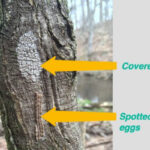Cockroaches are a common household pest, and while many people are familiar with them scurrying across the floor, the idea of a flying cockroach can be particularly unsettling. In the United States, around 55 different species of cockroaches exist, and a significant number of these species are indeed capable of flight. However, the extent and manner of their flight vary considerably. Some roaches are adept fliers, readily taking to the air, while others may only use their wings for gliding short distances or rarely fly at all. Understanding Which Roaches Fly and how they utilize this ability is key to managing and preventing infestations.
Common Species of Flying Cockroaches
Several cockroach species are known for their flying capabilities. Among the most notable are Asian cockroaches, brown cockroaches, smokybrown cockroaches, and wood roaches. These species are equipped for more than just gliding; they can actively fly and often do so.
Alt text: Adult smoky brown cockroach next to its nymph stage, showcasing size difference in pest control context.
American cockroaches, while winged, are more commonly observed gliding rather than engaging in sustained flight. They might use their wings to descend from heights or move quickly across a room, but they are not as agile in the air as some other species.
Australian cockroaches, frequently found in warmer climates like the Gulf Coast region, are also recognized as proficient fliers. Their ability to fly enhances their dispersal and makes them a more mobile pest.
Cuban cockroaches, known for their distinctive bright green color, are another species confirmed to be capable of flight. Their vibrant appearance sets them apart, but their flying behavior is consistent with other flying cockroach species.
Cockroaches Incapable of Flight
In contrast to the flying varieties, some cockroach species are not capable of flight at all. German cockroaches and Oriental cockroaches fall into this category. These species lack the ability to fly and rely solely on crawling and running for locomotion.
Alt text: Close-up of an adult female German cockroach carrying an egg capsule, highlighting reproductive aspect of indoor pest.
Why Flying Cockroaches Enter Homes
Flying cockroaches are often drawn to indoor environments due to artificial lights. Their attraction to light sources can lead them to fly inside through open doors and windows. Being nocturnal creatures, their activity often goes unnoticed initially, allowing infestations to develop before being detected. Many homeowners are surprised to learn that cockroaches can fly, often realizing this only when populations grow large enough to be seen during daylight hours. Signs of a cockroach problem, whether flying or non-flying, include a musty odor, visible droppings, and shed skins.
Problems Associated with Flying Cockroaches
The ability of cockroaches to fly introduces additional challenges when dealing with infestations in homes. Flight allows them to disperse more easily throughout a building, reaching upper levels and accessing difficult-to-reach hiding spots.
Accessing High Places and Contamination
While not built for prolonged flight, flying cockroaches can use bursts of flight to reach food sources located on countertops, shelves, and in pantries. This behavior increases the risk of food contamination as they can readily transfer bacteria and pathogens from unsanitary areas to food preparation surfaces and stored food items. Consumption of food contaminated by cockroaches can lead to illnesses such as dysentery and food poisoning.
Entering Through Openings
Flying cockroaches can enter homes not only through ground-level access points but also through windows and open doors, even on upper floors. Their flattened bodies enable them to squeeze through small cracks in window frames, siding, and foundations. They may also fly or crawl into gaps around appliances and behind cabinets, making them harder to eliminate and control.
Factors Attracting Flying Cockroaches
Besides light, flying cockroaches are attracted to warmth and moisture. They are often found congregating near heat sources like heaters and heating ducts, as well as around areas with moisture, such as leaky air conditioning units, sinks, and bathtubs. They may also enter homes via infested items like cardboard boxes and grocery bags, or through utility pipes and structural weaknesses in buildings. While many flying cockroach species might not survive indoors for extended periods, their presence is still a significant nuisance and health concern.
Health Risks Posed by Flying Cockroaches
Infestations of flying cockroaches can persist for extended periods without detection due to their nocturnal habits. They hide during the day and forage for food at night, feeding on decaying organic matter and food scraps. Cockroach allergens, found in their droppings and shed skins, can exacerbate allergies and trigger asthma symptoms, particularly in sensitive individuals. Adult cockroaches can live for over a year, continually contaminating food supplies and surfaces. Their role as vectors of viruses, fungi, and bacteria means they can transfer pathogens to food items like rice, bread, and peanuts, increasing the risk of gastroenteritis, dysentery, and food poisoning for residents.
Eliminating Flying Roaches
To effectively manage and eliminate flying cockroach infestations, it is advisable to seek professional pest control services. If you suspect a flying cockroach problem or want to prevent one, contacting pest control experts like Orkin at the first sign of cockroach activity is a recommended step. They can properly identify the species, assess the extent of the infestation, and implement targeted treatment strategies.

